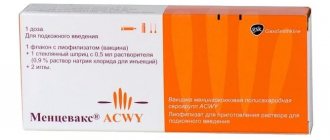ANTI-RABIBES VACCINE INACTIVATED CULTURAL LIQUID (FGU)
Home / Catalog of veterinary drugs / Biological products / Vaccines used for animals of different species / ANTI-RABIBES INACTIVATED CULTURAL LIQUID VACCINE (FGU)
Attention! This guide is available on CD. Detailed information about all drugs, easy search, automatic catalog update. More details »»
Alphabetical index | Drugs by manufacturer | Medicines by disease | Search
Name ANTI-RABICE VACCINE INACTIVATED CULTURAL LIQUID (FGU) Composition and release form Made from the Shchelkovo-51 strain grown in a suspension culture of BNK-21 cells. In appearance, the vaccine is a transparent liquid of light yellow or pink color with a light gray sediment, which breaks easily when shaken. The vaccine is available in bottles of 6, 10, 20, 50, 100 and 200 ml. Pharmacological properties The vaccine induces the production of specific humoral immunity. The vaccine is harmless and non-reactogenic. Immunity occurs 21 days after vaccination and lasts 12 months. Indications For preventive and emergency immunization of large and small ruminants, pigs, horses, dogs and cats against rabies. Doses and method of administration Preventive immunization of animals against rabies is carried out once, followed by revaccination after 1 year. Animals previously vaccinated against rabies are vaccinated once a year. Forced vaccination for therapeutic purposes is carried out no later than 48 hours after possible infection of the animal. The vaccine is administered twice with an interval of 7 days in the doses indicated below. Before use, vaccine vials are shaken thoroughly. The vaccine is administered subcutaneously in the neck area for large and small cattle, horses, dogs, cats, and intramuscularly behind the ear for pigs. Before and after use, syringes and needles are sterilized by boiling for 30 minutes. The drug is administered subcutaneously in compliance with the rules of asepsis. The injection site is wiped with 70% alcohol or 0.5% carbolic acid solution. A swelling may appear at the injection site, which disappears after 7 days. Cattle and small cattle, horses, pigs are vaccinated from 3 months of age, dogs and cats from 2 months of age. Single doses of vaccine administration for preventive and emergency purposes, (ml): horses, cattle - 5; pigs - 3; sheep and goats, large dogs (shepherds, St. Bernards, etc.) - 2; cats, 2-month-old puppies of all breeds, adult dogs of small breeds (lapdogs, dachshunds, spitz, terriers, etc.) - 1. No side effects. Contraindications: Clinically sick animals. Special instructions Meat and milk from vaccinated farm animals are used without restrictions, regardless of the timing of vaccine administration. Vials of the vaccine without labels, with broken seals, containing impurities that have been frozen, and not used within 8 hours after opening, must be rejected and disposed of by boiling for 10 minutes. Storage conditions: In a dry, dark place at a temperature of 2 to 8 °C. Shelf life: 12 months. Manufacturer Federal Center for Animal Health FGU (ARNIIZH FGU), Russia
Address: 600901, Vladimir, microdistrict.
Yuryevets. Tel. Tel./fax E-mail More about the manufacturerAll drugs produced by the Federal Center for Animal Health FGU (ARRIAH FGU), Russia
Seller Place of your advertising
Regarding information placement
about veterinary drugs and feed additives
in the Electronic Directory “Veterinary Drugs in Russia”
and concluding publishing agreements
contact Vettorg LLC by email
Rabipur® (Rabipur culture purified inactivated vaccine) (Rabipur)
Method of administration
The Rabipur® vaccine must be administered intramuscularly into the deltoid muscle, and in young children (up to 18 months) - into the anterior lateral surface of the thigh.
UNDER NO CIRCUMSTANCES SHOULD THE VACCINE BE ADMINISTERED INTRAVASCULARLY!
Accidental entry of the vaccine into a blood vessel may result in a severe reaction, including shock. In such cases, urgent measures should be taken immediately to prevent such a reaction.
The vaccine should not be administered into the gluteal muscle or subcutaneously, as this may prevent an adequate immune response.
When the Rabipur® vaccine is prescribed on the same day as other vaccines, they should be administered to different parts of the body, preferably located on opposite limbs.
Before use, the solvent and reconstituted vaccine must be visually checked for the absence of mechanical inclusions and/or changes in appearance (see section “Description”). If they are detected, you should stop using the solvent or reconstituted vaccine.
The lyophilisate should be dissolved in the supplied water for injection immediately before use. Before administration, the solution must be shaken carefully to avoid the appearance of foam. The reconstituted vaccine cannot be stored and must be used immediately after preparing the solution. The vaccine does not contain preservatives, so special care must be taken to prevent contamination of the reconstituted vaccine.
Vaccination schedules
A single dose for immunization is 1.0 ml for adults and children of all ages.
Pre-exposure immunization
Three-time immunization according to the following scheme: 1 immunizing dose (1.0 ml) on days 0, 7 and 21 or 28.
Revaccination
Persons at constant risk of infection are recommended to monitor the level of specific antibodies in the blood once every 6 months.
Persons with a frequent risk of infection are recommended to monitor the level of antibodies in the blood once every 2 years.
If the level of antibodies in the blood decreases below 0.5 IU/ml, a single revaccination is carried out with one immunizing dose.
Immunization with the Rabipur® vaccine provides a pronounced immune response and a protective level of specific antibodies circulating for a long time.
In cases where it is not possible to establish a serological reaction, the first revaccination is recommended to be carried out one year after the course of immunization. Subsequent revaccinations are carried out once every 5 years with one immunizing dose.
Post-exposure immunization
Post-exposure prophylaxis of rabies includes the following steps:
- measures for emergency wound treatment;
— introduction of a vaccine to prevent rabies, consistent with WHO recommendations;
— administration of rabies immunoglobulin if indicated.
Indications for post-exposure prophylaxis depend on the category of contact with an animal suspected of rabies and are listed in Table 1. Post-exposure immunization should begin as soon as possible after contact and be carried out along with local wound treatment to reduce the risk of infection.
Measures for emergency wound treatment (local treatment)
For persons who have been in contact with animals suspected of rabies, the following measures are required: as soon as possible after a bite or injury, all wounds and injuries should be immediately washed with plenty of water using soap or other detergent (detergent) for several minutes (up to 15 minutes). ). Then the edges of the wound must be treated with 70% ethyl alcohol or a 5% alcohol solution of iodine.
If possible, wounds should not be stitched. Suturing is indicated only in the following cases:
- extensive wounds (several guiding skin sutures should be applied after pre-treatment of the wound);
- applying skin sutures to facial wounds;
- suturing of bleeding vessels in order to stop external bleeding.
If there are indications for the use of rabies immunoglobulin, it is used immediately before suturing. The recommended dose of immunoglobulin should be injected as deep as possible into the wound and adjacent areas. The remaining immunoglobulin should be injected intramuscularly at a site other than the vaccine site, preferably the gluteal muscle.
If necessary, tetanus prophylaxis should be administered.
Table 1. Post-exposure immunization schedules for different exposure categories
Contact category | Nature of contact (contact with an animal with confirmed or suspected rabies, contact during autopsy of the animal) | Immunization schedule |
| I | Touching or feeding animals in the absence of salivation of the skin and mucous membranes and damage to the patient’s skin before and after contact. | No vaccination required. In doubtful cases, vaccination is recommended according to the following schedule: 1.0 ml of Rabipur® vaccine on days 0, 3, 7, 14, 30 and 90. |
| II | Salivation of intact skin; abrasions, scratches, superficial non-bleeding bites of the torso, upper and lower extremities (except for bites of dangerous localization: head, face, neck, hand, fingers and toes), inflicted by domestic and farm animals. | In case of a bite from a domestic or known animal, immediate treatment is prescribed according to the following regimen: 1.0 ml of Rabipur® vaccine on days 0, 3, 7, 14, 30 and 90. In the event of a bite from an unknown or suspected rabies animal, immediate combination treatment (active and passive immunization) is prescribed according to the following regimen: rabies immunoglobulin on day 0 and 1.0 ml of Rabipur® vaccine on days 0, 3, 7, 14, 30 and 90 . If the observed pet remains healthy for 10 days, treatment is stopped*. In other cases, treatment should be continued. If it is laboratory proven that the animal is not rabid, then treatment is stopped*. |
| III | Any drooling of the mucous membranes, any bites of the head, face, neck, hand, fingers and toes, genitals; single or multiple deep, bleeding lacerations caused by domestic or farm animals. Any salivation and damage caused by wild carnivores, bats and rodents. | Immediate combination treatment (active and passive immunization) according to the following scheme: rabies immunoglobulin on day 0 and 1.0 ml of Rabipur® vaccine on days 0, 3, 7, 14, 30 and 90. If the observed pet remains healthy for 10 days or the absence of rabies in the animal is laboratory proven, treatment is stopped*. In other cases, treatment should be continued. |
*The patient should be advised that immunization is not complete. In case of subsequent contact with an animal suspected of rabies, a full course of vaccination is required.
If it is necessary to carry out a combined course of anti-rabies treatment, anti-rabies immunoglobulin is first administered and then the Rabipur® vaccine is administered no more than 30 minutes later. Heterologous anti-rabies immunoglobulin is prescribed at a dose of 40 IU per 1 kg of body weight, and homologous anti-rabies immunoglobulin is prescribed at a dose of 20 IU per 1 kg of body weight. It is not allowed to exceed or reduce the dose, nor to re-administer it due to the risk of reducing the effectiveness of vaccination. If rabies immunoglobulin is not available at the time of the first injection, it should be administered no later than 3 (rabies immunoglobulin from equine blood serum (heterologous)) or 7 (rabies immunoglobulin from human blood serum (homologous)) days after the bite.
Post-exposure immunization of fully immunized individuals
To resolve the issue of tactics for providing anti-rabies care to persons who have a history of having completed a full course of anti-rabies vaccination, it is recommended to determine the level of anti-rabies antibodies in the blood. The protective level of antibodies is > 0.5 IU/ml.
Depending on the duration of the rabies vaccination course, you should adhere to the regimens indicated in Table 2.
Table 2. Vaccination schedules for persons previously immunized after a bite
| Interval after vaccination course | Vaccination scheme |
| Less than 1 year (subject to completion of the full course of vaccination) | Vaccination on days 0, 3, 7 with 1.0 ml of Rabipur® vaccine |
| More than 1 year | Full immunization according to the post-exposure immunization schedule (according to the category of contact) |
Persons with immunodeficiency conditions
Persons with immunodeficiency conditions receiving post-exposure rabies treatment are recommended to monitor the protective level of antibodies in the blood 14 days after completion of the vaccination course. Depending on the level of protective antibodies detected, additional vaccine administration may be necessary. If the antibody level is below the protective level (≥ 0.5 IU/ml), an additional three-time administration of the vaccine is necessary according to the following schedule: days 0, 7, 21 or 28.





